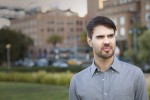Aaron Koblin boarded a train so he could shine a laser onto the landscape, creating a work of art of colorful moving images as he traveled through the country.
Koblin, a UCLA Design | Media Arts alumnus, created “Light Echoes” in 2013 alongside multimedia artist Doug Aitken, traveling 4,000 miles across the country to film 62 one-minute bits. Koblin was able to take long exposure photos of the patterns and words he produced using the laser while on board the train, which passed through rural environments in Southern California.
Throughout his career, Koblin has used technology to create award-winning visual art projects such as “Light Echoes.” Koblin’s interest in technology has also extended to his current exploration of virtual reality projects through his company Within, which he co-founded alongside another director.
On Thursday, he will speak at The Geffen Contemporary at the Museum of Contemporary Art in an exhibit called “The Idea of Time” about two of his works, “Flight Patterns” and “Light Echoes.” Koblin and Los Angeles-based artist Liz Glynn will talk about how they perceive and implement the concept of time into their work.
The Daily Bruin’s Roberto Luna Jr. spoke with Koblin about his talk on Thursday, how he views time and his thoughts on technology fused with art.
Daily Bruin: How did “Flight Patterns” and “Light Echoes” come about? What technologies did you use?
Aaron Koblin: For “Light Echoes,” Doug Aitken reached out to me a couple of years ago about how he was going to get on a train to travel across the country. I then thought to myself, “If you had a train, what kind of art could you do?” I then started thinking about space and time. I imagined the train moving across the country like a piece of paper going through a printer. I started figuring out how to use a laser controlled through a computer to produce images on the landscape.
I developed “Flight Patterns” as a graduate student here at UCLA with statistics about (airline) flight patterns in the United States. We did a lot of data visualization projects (when I was a student) alongside professors. I recently updated the project using data from 2015 so you can tell the differences across time.
DB: The exhibit is titled “The Idea of Time.” How would you define time?
AK: That’s part of what I’ll talk about on Thursday, that time is a relative attribute and humans are aligned to a specific scale. I think when you look at time lapse photography, it allows us to re-examine time, and look at large quantities of it. Because we live in a specific scale of time, we can’t perceive many systems. It’s a reminder that time doesn’t have the same limitations as us.
DB: Can you elaborate more on how you’ve seen art evolve alongside technology? Where do you see it going and where do you see yourself in it?
AK: Art has always been used to reflect on politics, culture and the state of man. Technology has allowed us to take that further. A lot of art has to do with with space and time. It’s important for art to keep up with technology.
I’m also interested in virtual reality. It’s what people have been trying develop for a century. It has the ability to transport us to different places and gain access to a lot of things.
DB: Is there some kind of connection between all the works you have done and all the different modes you’ve used?
AK: All of my works are based on relating technology to humanity. They’re about how can we use these new tools for something that hasn’t been done before and falls outside their normal use.
